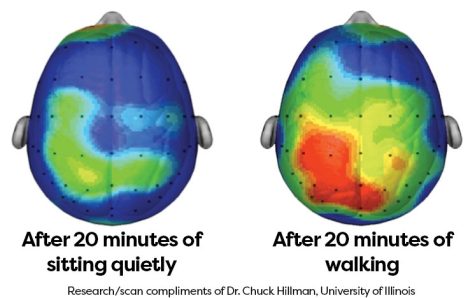Is sitting really the new smoking?
Research suggests too much time sitting has a negative effect on your health
Designed in Canva by Sam Westerman
It’s time to get moving: Evidence shows sitting not only affects your healthy but your academic performance as well.
February 24, 2023
What if I told you that making a simple change to your daily life would improve your health as much as quitting smoking? Surprising as that may sound, growing research – and a groundbreaking study from 70 years ago – point to this conclusion.
Where it Started
London, England, is the home to red, iconic, double-decker buses that serve the city’s public transportation system. On each bus, there are two workers.
Worker A is the driver. Not surprisingly, the bus driver sits buckled in his seat all day long, navigating the busy streets of one of the world’s iconic cities. Worker B is the conductor. Unlike the driver, Worker B is on his/her feet all day long. Worker B is responsible for punching in the riders’ tickets, constantly ascending and descending the bus stairs. Conductors are estimated to climb around 750 steps every day.
How do these facts relate to health? A 1953 study found that one of the two workers is twice as likely to die from heart complications. Can you guess which one?
The Dangers of Prolonged Sitting
If your guess was Worker A, you are correct. The landmark 20th-century kinesiology study also confirmed that the sudden death rate was three times higher in drivers and that the drivers’ uniforms tended to be plus-sized: indicating higher body masses for the sedentary occupation.
Furthermore, Workers A and B were from similar social groups, having similar education levels and backgrounds. The main difference between Workers A and B was that one occupation required the person sit all day, while the other spent the day standing, walking and climbing.
The London bus study suggests that sitting for extended periods contributes to negative impacts on the cardiovascular system. Yet more importantly, it pioneered a new wave of research regarding prolonged sitting and its ability to cause cardiovascular diseases.
Researchers have conducted abundant studies on the topic over the last 70 years, often referencing the workers on the red buses. In 2011, a study by the European Association for the Study of Diabetes (EASD) reestablished that sitting for long periods can be associated with cardiovascular diseases and death. It also demonstrated that a habit of prolonged sitting could force the human body into a state of insulin resistance, which describes what occurs when the body’s cells don’t appropriately respond to insulin.
Insulin regulates the amount of glucose in the bloodstream; without it, glucose can begin to build up in the blood. This is one of the causes of type 2 diabetes. The EASD stated that the association between sitting and type 2 diabetes was stronger than between sitting and cardiovascular illnesses and sitting and death.
The most prevalent finding in studies on sedentary activities is that a general lack of movement contributes to obesity. This was demonstrated in the average measurements of workers’ uniforms in the London study. It continues to be shown in the array of recent studies revealing how sitting drastically slows down metabolism.
Reeka B. Kumar, M.D., is an endocrinologist dedicated to understanding what causes weight-management disorders. When Health Matters spoke with her, she stressed that prolonged sitting decreases one’s metabolic rate, which is immensely harmful to the human body. “A healthy metabolic rate and appropriate use of nutrients by our muscles keep our bodies in a healthy balance,” Kumar describes. “Once this deteriorates, other parts of our health are affected, including cholesterol and fat metabolism, blood pressure, and joint mobility.”
Effortless Improvements to Health
Many occupations require movement by nature. A high school administrator is a profession that does not fit this description.
Associate Principal of Educational Services Patrick Sassen is responsible for building the master schedule in the spring. It includes the daily schedule for every teacher and student in the building.
“It requires a lot of time on the computer,” he said. “Hours of data entry.” Mr. Sassen recognized he didn’t feel comfortable sitting at his computer for hours on end.
“I noticed that when sitting for several hours, I’d be far more tired than I thought I should be. I found myself with a lot less energy.”
At this point, Mr. Sassen made an important decision: “I decided that I didn’t want to be sitting for that whole period of time. I was going to do it standing up.”
He has since mounted a standing desk in his office and noticed a vast amount of ways that his well-being has changed. “There’s no doubt that my productivity levels have changed,” Sassen said. “I feel like, because my legs are engaged all day, it keeps me active. I’ve noticed a tighter core, which leads to better balance.”
It’s been known for a while that physical activity limits the odds of falling ill to heart disease: the leading cause of death for both genders and most ethnic groups in America. The American Heart Association says that only 30 minutes of moderate exercise is necessary to meaningfully lower the risk of cardiovascular illnesses.
Movement in Education
Physical activity helps people to maintain healthier bodies. However, an active lifestyle can generate better academic performance too.
Eric Jensen is a world-class neuroscientist famous for writing Brained-Based Learning: Teaching the Way Students Really Learn. In the informative book, Jensen said that humans are bound to lose attention after 20 minutes of sitting. He describes how movement is necessary for focus: the increased blood flow re-engages the brain.
An important excerpt from Jensen’s book states: “You can either have your learner’s attention or they can be making meaning, but never both at the same time… We absorb so much information that downtime is absolutely necessary to process it all… Without this, learning drops dramatically.”
Before starting at LFHS, Assistant Principal Alan Wahlert had the opportunity to learn from Jensen. Those sessions motivated Wahlert to implement movement in the classroom.
 He has observed the ease with which teachers and students lose focus: “Above all else, the longer they are taking ‘input’, the harder it is to maintain focus.” He also said how integrating physical activity has helped students stay productive: “When teachers incorporate ‘student output,’ this tends to increase engagement.”
He has observed the ease with which teachers and students lose focus: “Above all else, the longer they are taking ‘input’, the harder it is to maintain focus.” He also said how integrating physical activity has helped students stay productive: “When teachers incorporate ‘student output,’ this tends to increase engagement.”
There are many ways in which students could implement activity into their school lives. Instead of walking to the next class for one or two minutes out of the five-minute passing period, people could take longer, less direct routes to their assigned rooms. Spending 15 extra minutes walking while in school is noticeably healthier for the brain than spending that time on social media.
Taking advantage of the school’s provisions also helps students stay active. “If students wanted to consider options for standing more throughout the day, the high-top tables in the commons are very easy to stand at,” Sassen said. “Students could stand at those during lunch or study hall.”
“It really falls on students’ teachers to be mindful of integrating movement, either formally or informally, into the classroom,” Wahlert said, giving examples for each. “I’ve seen LFHS teachers have students stand up, doing ‘speed dating,’ where partners interact and move on to different people. I’ve also seen teachers simply have students stand up and walk over to a classmate to give them a high five, then go sit back down. Neither activity disrupts learning time, but they help students move, getting re-engaged.”
A Call to Action
Ultimately, it’s important to remember to engage in physical activity daily, despite how much society has normalized a sedentary lifestyle. It can be easy to undermine the legitimate consequences of prolonged sitting because it does not pose any short-term problems. Nevertheless, it’s clear that years of sitting wreak havoc on the human body decades later.
“The cumulative damage of sitting for prolonged periods of time, over several years, can be equated to the negative health consequences of smoking,” Dr. Kumar, M.D. said. “Sitting, like smoking, can be correlated with negative health outcomes in every system from our heads, down to our toes, and even our skin.”








Jason • Feb 28, 2023 at 2:35 pm
One of the simplest ways to break out of a sedentary lifestyle is to actively commute – to walk or cycle as a primary form of regular travel. Use of active and semi-active transport has been proven to have significant health benefits over driving.